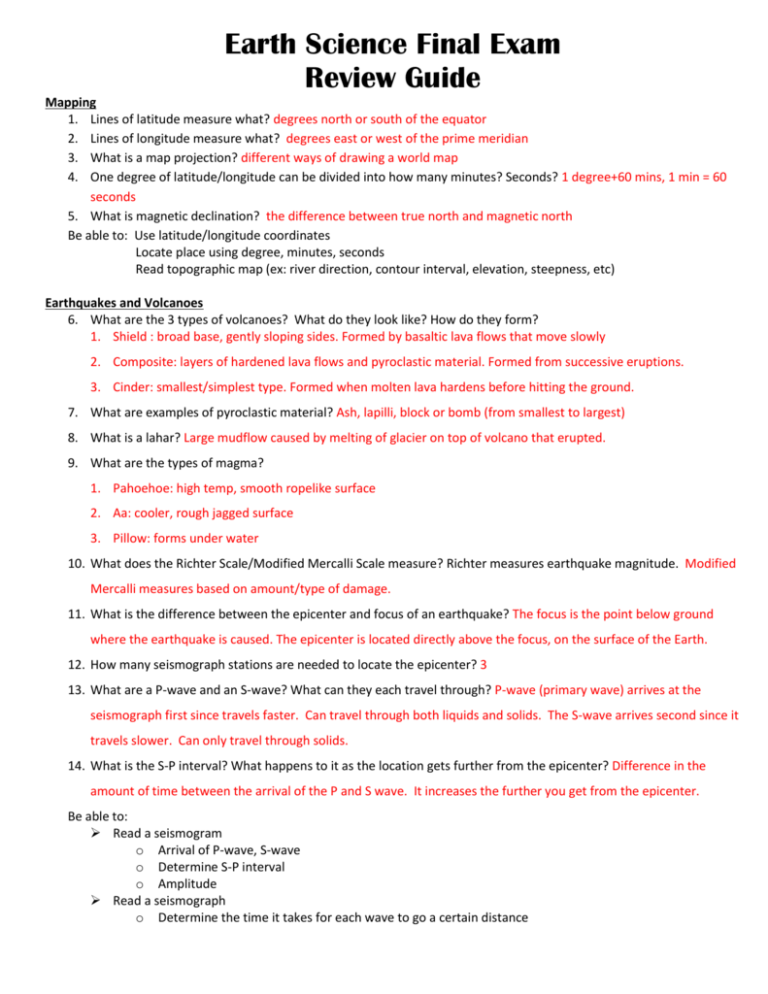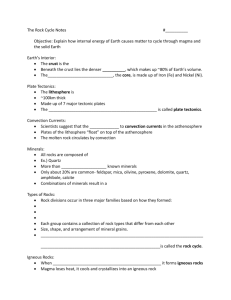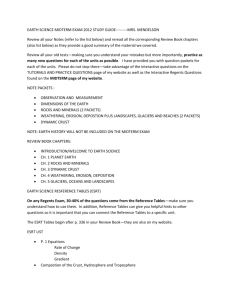Earth Science Final Exam
advertisement

Earth Science Final Exam Review Guide Mapping 1. Lines of latitude measure what? degrees north or south of the equator 2. Lines of longitude measure what? degrees east or west of the prime meridian 3. What is a map projection? different ways of drawing a world map 4. One degree of latitude/longitude can be divided into how many minutes? Seconds? 1 degree+60 mins, 1 min = 60 seconds 5. What is magnetic declination? the difference between true north and magnetic north Be able to: Use latitude/longitude coordinates Locate place using degree, minutes, seconds Read topographic map (ex: river direction, contour interval, elevation, steepness, etc) Earthquakes and Volcanoes 6. What are the 3 types of volcanoes? What do they look like? How do they form? 1. Shield : broad base, gently sloping sides. Formed by basaltic lava flows that move slowly 2. Composite: layers of hardened lava flows and pyroclastic material. Formed from successive eruptions. 3. Cinder: smallest/simplest type. Formed when molten lava hardens before hitting the ground. 7. What are examples of pyroclastic material? Ash, lapilli, block or bomb (from smallest to largest) 8. What is a lahar? Large mudflow caused by melting of glacier on top of volcano that erupted. 9. What are the types of magma? 1. Pahoehoe: high temp, smooth ropelike surface 2. Aa: cooler, rough jagged surface 3. Pillow: forms under water 10. What does the Richter Scale/Modified Mercalli Scale measure? Richter measures earthquake magnitude. Modified Mercalli measures based on amount/type of damage. 11. What is the difference between the epicenter and focus of an earthquake? The focus is the point below ground where the earthquake is caused. The epicenter is located directly above the focus, on the surface of the Earth. 12. How many seismograph stations are needed to locate the epicenter? 3 13. What are a P-wave and an S-wave? What can they each travel through? P-wave (primary wave) arrives at the seismograph first since travels faster. Can travel through both liquids and solids. The S-wave arrives second since it travels slower. Can only travel through solids. 14. What is the S-P interval? What happens to it as the location gets further from the epicenter? Difference in the amount of time between the arrival of the P and S wave. It increases the further you get from the epicenter. Be able to: Read a seismogram o Arrival of P-wave, S-wave o Determine S-P interval o Amplitude Read a seismograph o Determine the time it takes for each wave to go a certain distance Plate Tectonics 15. What are the layers of the Earth? Inner Core: Solid, made mostly of Iron and Nickel Outer Core: Liquid, also Iron and Nickel Mantle: Iron, Silicon, and Magnesium. Solid, but behaves more like a liquid due to high pressure and temperatures. Crust: thin, outer layer Lithosphere: Composed of the crust and uppermost portion of the mantle. Asthenosphere: Thin, plastic like flow 16. What is the theory of continental drift? Who proposed it? All continents had once been joined together. Proposed by Alfred Wegener. 17. What evidence was used to support continental drift? Puzzle-like fit of continents, rock formations (matching mountains), fossils (found on coasts of s. America and Africa), climate evidence (like location of glaciers) 18. Why was it not accepted? Wegener couldn’t explain why or how the continents moved. 19. What is the theory of plate tectonics? Earth’s crust and rigid upper mantle move in different directions and at different rates over Earth’s surface. 20. What do the plates move on? What causes them to move? Asthenosphere. Caused by convection currents within the mantle. 21. What occurs at a mid-ocean ridge? Divergent boundary, new seafloor is being created. 22. What happens to age of seafloor as you get farther from the ridge? Gets older 23. Differences in ocean and continental crust. Which is thicker? Which is more dense? Oceanic crust is thinner but more dense which is why is always subducts below continental crust which is thicker but less dense. 24. Types of boundaries: What is happening to the plates? What landforms are being created? How? (ex: pressure decreasing, increase water, etc) Mid ocean ridges or rift zones. Magma is caused by a decrease in pressure. Divergent Two plates are moving apart from each other. Convergent One plate is subducting under another. Whichever one is more dense is the one that will subduct. This forms volcanoes. If it is a continental-oceanic boundary it will form volcanoes. If it is a oceanicoceanic boundary it will form island arcs. A continental-continental boundary will form mountains. Magma caused by increase in water. Transform Plates slide back and forth against each other. Forms faults such as the San Andreas fault. Rocks and Minerals 25. List and describe the characteristics of a mineral. 1. Naturally Occuring 2. Solid 3. Definite Chemical Composition 4. Crystalline Structure (arrangement of its atoms) 5. Inorganic (never alive) 26. How do you identify minerals? List and explain each one. 1. Color 2. Luster (how shiny it looks – metallic or non-metallic) 3. Texture (how it feels to the touch) 4. Streak (run mineral across streak plate to find color of its powder left behind) 5. Hardness (Moh’s hardness scale; the harder object will scratch the softer object) 6. Breakage 7. Specific Gravity 8. Density (mass/volume. Use triple beam balance to find mass, and water displacement to find volume) 27. What is the least reliable characteristic to identify minerals? color 28. What is a gem? Ore? Gem is valued for beauty or rarity. Ore is mined for profit (iron, etc) 29. What are the mineral groups? What elements does each one contain? 1. Silicates: contain silicon, oxygen, and one other metal 2. Carbonates: contain carbon and three oxygen 3. Oxides: metal and oxygen 4. Sulfide: metal and sulfur 5. Native Element: contain only 1 element (gold, silver, etc) 30. How are each of the 3 rock types formed? 1. Igneous: formed from melted magma 2. Metamorphic: formed from heat and pressure 3. Sedimentary: compaction of sediments 31. What determines crystal size of igneous rocks? How fast they cool. Rocks that cool slow have large crystals are called intrusive. If cool quickly have very fine crystals or are glassy, these are called extrusive. 32. What is mafic/felsic? How can you visually tell what rocks are mafic or felsic? Felsic magma is thick, slow moving, with a high silica content. It will form light colored rocks. Mafic is opposite and will form dark colored rocks. 33. What is a pluton? Rock mass that forms when magma cools inside the Earth. Will always be made of intrusive igneous rocks. 34. What are the types of sedimentary rocks? 1. Clastic: form from fragments of other rocks. 2. Chemical: water evaporates and leaves behind dissolved substances. 3. Organic: formed from the remains of once living things, like coal. 35. What are the types of metamorphism? 1. Local: occurs over small area. Two types: contact and deformational. Contact occurs when rock is heated by hot magma without melting it. Deformational occurs typically along faults. 2. Regional: occurs over a larger area usually during mountain building. 36. What is foliation? What type of rock does it occur in? Bands or layers of minerals. Occurs in metamorphic rocks. 37. What types of rocks contain fossils? Sedimentary Be able to: Use the Igneous identification chart (what minerals make up rocks, what ones are ultramafic, etc) Geologic Time 38. What is the difference between relative and absolute time? Relative time puts things in the order in which they occurred. Absolute time places an actual date of the event. Radioactive dating is most commonly used to find this. 39. What are the laws of stratification? The Law of Superposition: In any undisturbed sequence of strata, the oldest layer is at the bottom of the sequence, and the youngest layer is at the top of the sequence. The Cross-Cutting Law : Any feature that cuts across a body of sediment or rock is younger than the body of sediment or rock that it cuts across. The Law of Inclusions: If one rock body contains fragments of another rock body it must be younger than the fragments of rock it contains. OR…The inclusions are older than the rocks which contain them. 40. What is a half-life? The amount of time it takes for half of the original parent material to decay into daughter. 41. What is the current era and period? Cenozoic era. Quarternary period. Be able to: Determine the order that rock layers occurred Weathering and Erosion 42. Definition and examples of mechanical weathering. Disintegration of rock, also called physical weathering. Examples include: ice, abrasion, plants/animals, exfoliation. 43. Definition and examples of chemical weathering. Decomposition of rock. The minerals are actually changed. Examples: hydrolysis, acid rain, oxidation. 44. What climate does chemical weathering occur the fastest? Wet and warm 45. What are the agents of chemical weathering? Water, Carbon Dioxide, Oxygen 46. What is soil? Mixture of loose, weathered rock and organic matter. 47. What factors affect the composition of a soil? Which has the greatest influence? Time, parent material, topography, climate. Climate has the greatest influence. 48. What do the striations of a glacier show? Direction of movement 49. What happens to the amount of erosion as the velocity of a river increases? increases Be able to: Use the soil texture triangle







